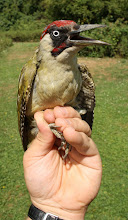After scoping out a new site (a field with a cover crop near Sandy Smith Nature Reserve) and gaining permission to ring there (thanks Chris), I had to wait a while before the weather decided to produce ringing conditions.
Whilst snow was still on the ground, I had seen at least 300 birds including species such as Reed Buntings, Linnets, Lesser Redpolls, Yellowhammers, Skylarks, Green Woodpeckers, Goldfinch, Blackbirds and Chaffinches in the cover crop. I was sure at least some of the species were catchable and could include birds ringed at SSNR.
The weather finally relented yesterday and despite the weather being a lot milder and fewer birds being about, I did well.
Totals: 70 birds of 11 species comprising of 66 new and 4 retraps (retraps in brackets below):
Great Spotted Woodpecker 1 (0)
Dunnock 6 (0)
Robin 1 (0)
Blackbird 1 (0)
Blue Tit 6 (1) - retrap ringed at SSNR 15/07/12, 209 days ago
Great Tit 1 (0)
Chaffinch 4 (1) - retrap ringed at SSNR 24/11/12, 77 days ago
Goldfinch 1 (0)
Lesser Redpoll 1 (0)
Reed Bunting 41 (2) - both retraps ringed at SSNR 11/03/12, 335 days ago
Yellowhammer 3 (0)
A few record photographs:
Above: A female Reed Bunting
I hadn't expected so many Reed Buntings (I didn't use binoculars or count numbers of each species when I looked at the site) but I'm not complaining... any large catch of Reed Buntings is a red letter day around these parts!
Above: A male Chaffinch
I had expected more Chaffinch to be about, perhaps one of the species that had dispersed since the cold snap (there were fewer Goldfinch too). I did expect to catch a retrap Chaffinch from SSNR where I have ringed 83 in the last few years and I did, albeit a recent one. If I get my timing right, I'm sure there'll be more Chaffinch to ring and retrap.
Above: A male Reed Bunting
From 10 birds ringed at SSNR in the few years, it was nice to retrap 2 of them - both ringed at the same time on the same day. With no retrap records for either site for this species prior to yesterday, the second of the 2 is now the longevity record for both sites by virtue it was recaught a couple of hours later than the first.
Above: A Blue Tit
Catching Blue Tits I'd ringed at SSNR was inevitable really. They must pass between my feeders at SSNR and the residents feeders at Beadlow - they're only a kilometre apart. The retrapped bird was only retrapped for the first time, perhaps showing it prefers the feeders at Beadlow!
Above: A Great Tit
The nets weren't in the ideal position for catching passing Blue & Great Tits but that obviously didn't matter.
Above: A female Yellowhammer
I have ringed Yellowhammer before (East Yorkshire & Cambridgeshire) but have never caught my own. Yellowhammers have been declining rapidly since the 1980's and may well continue to do so. You can read more about the decline of Yellowhammers on the BTO website
here.
Above: A male Lesser Redpoll
I had hoped for a few more of these, but given the milder conditions and location of my nets, this wasn't altogether a surprise.
Above: A Goldfinch
The Goldfinch I had seen before on this site must have dispersed as a lot fewer were seen this time.
Above: A Robin
I'd only seen one Robin here and I saw it collecting nesting material and taking it back to an ivy clad tree. Perhaps this was the one I saw?
Today, the weather has worsened (yet again) so it's chores, chores, chores.... and preparing the equipment for the next ringing session. I have a few pleasant diversions such as remembering yesterdays session, playing the X Box and the England rugby match is on later (though whether this is a pleasant diversion depends on the result!).















































